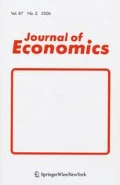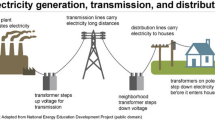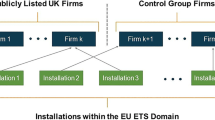Abstract
We analyze the effect of mergers on optimal environmental taxation in a Cournot oligopoly market with product differentiation. Our result indicates that the adjustment in emission tax crucially depends on the post-merger output distortion and pollution intensities. Specifically, we find that the optimal emission tax increases post-merger as long as pollution intensity of firms is higher and output distortion smaller post-merger than pre-merger. Furthermore, our result suggests that there is no need to revise environmental policy in markets where pollution intensity of firms does not change post-merger and (i) products are completely differentiated, or (ii) there are many firms for any degree of product differentiation.



Similar content being viewed by others
Notes
This ratio arises from differentiation of \(C_{e}(q,e)\); that is, \(dC_{e}=C_{eq}dq+C_{ee} de=0\Rightarrow -C_{eq}/C_{ee}\).
Notice that for (i) the pollution intensities, \(\delta _{m}\) and \(\delta \), are the terms associated with emissions, and for (ii) the pollution intensities are associated with the output distortion.
We use the fact that at \(\gamma =1\): \(2q_{1}=\tilde{q}\) and \(2\partial q_{1}/\partial t_{m} = \partial \tilde{q}/\partial t_{m}\).
This expression is analogous to (23).
It is noteworthy that in (30) the tax \(t_{m}\) is a function of \(\delta _{m}\) and thus \(t_{m}\) may rise/fall as \(\delta _{m}\) rises. There are two possibilities. First, the tax may rise as \(\delta _{m}\) rises. In this case the increase in the tax post-merger compensates the increase in \(\delta _{m}\): the numerator in the left-hand-side of (30) becomes smaller via the tax and also via the pollution intensity (for given tax). The left-hand-side term of (30) becomes smaller faster than the right-hand-side because of three factors: a larger denominator and a smaller numerator both through a reduction in \(\delta _{m}\) and \(t_{m}\). The right-hand-side term becomes smaller just via a reduction in the tax. Second, the tax post-merger may fall as \(\delta _{m}\) rises thus having an ambiguous effect on the numerator of the left-hand-side term of (30). We are interested in the first case (i.e., where \(t_{m}\) rises with \(\delta _{m}\)) since this case yields a clear-cut result which illustrates the factors leading to a larger tax post-merger even in the presence of restricted output due to the merger. The case where \(t_{m}\) rises (falls) with an increase in \(\delta _{m}\) can be interpreted as a situation where the government puts more (less) weight on addressing higher pollution.
The role of commitment in policy making is important. For instance, Dixit et al. (1997) emphasizes the importance of commitment in government policy making. Likewise, Aidt (1998) presents factors that cause governments to adopt taxes that considerably differ from the Pigovian rule. These aspects are key, but in this paper we assume governments will adopt optimal policies and there are no commitment issues on the side of the government.
References
Aidt TS (1998) Political internalization of economic externalities and environmental policy. J Public Econ 69:116
Bena J, Li K (2014) Corporate innovations and mergers and acquisitions. J Finance 69(5):1923–1960
Blonigen BA, and Pierce JR (2015) The effects of mergers and acquisitions on market power and efficiency. Retrieved from http://pages.uoregon.edu/bruceb/blonigen_pierce_aug2015
Carlsson F (2000) Environmental taxation and strategic commitment in duopoly models. Environ Resour Econ 15(3):243–256
Cellini R, Lambertini L, Ottaviano GIP (2004) Welfare in a differentiated oligopoly with free entry: a cautionary note. Res Econ 58:125–133
Collie DR (2003) Mergers and trade policy under oligopoly. Rev Int Econ 11(1):55–71
Damassa T, Bianco N, Fransen T, Hatch J (2012) GHG mitigation in the United States: an overview of the current policy landscape. World Resources Institute working paper
Dixit A, Grossman GM, Helpman E (1997) Common agency and coordination: general theory and application to government policy making. J Polit Econ 105(4):752–769
Ebert U (1992) Pigouvian tax and market structure: the case of oligopoly and different abatement technologies. FinanzArchiv/Public Finance Anal 49(2):154–166
Factset USA (2016) Flashwire US Monthly. US M&A News and Trends
Fikru MG, Lahiri S (2013) Cross-border mergers with flexible policy: the role of efficiency and market size. J Jpn Int Econ 34:58–70
Fikru MG, Gautier L (2016) Mergers in Cournot markets with environmental externality and product differentiation. Resour Energy Econ 45:65–79
Fujiwara K (2009) Environmental policies in a differentiated oligopoly revisited. Resour Energy Econ 31:239–247
FW Magazine (2012) Energy and utilities sector. Financier Worldwide Magazine December 2012. Financier Worldwide Magazine. Retrieved from http://www.bracewelllaw.com/assets/EnergyRT_Dec12%20(1).pdf. Accessed 11 Feb 2017
Gautier L (2013) Multilateral policy reform of emission taxes and abatement subsidies in a two-country model with oligopolistic interdependence. Environ Econ Policy Stud 15(1):59–71
Gautier L (2014) Policy reform of emission taxes and environmental research and development incentives in an international Cournot model with product differentiation. Environ Dev Econ 19(4):440–465
Gautier L (2015) Horizontal product differentiation and policy adjustment in the presence of abatement subsidies and emission taxes. J Environ Econ Policy 4(1):64–81
Gautier L (2016) Emission taxes and product differentiation in the presence of foreign firms. J Public Econ Theory. doi:10.1111/jpet.12204
Hettige H, Martin P, Singh M, Wheeler D (1995) The industrial pollution projection system policy research working paper. The World Bank
Huck S, Konrad KA (2004) Merger profitability and trade policy. Scand J Econ 106(1):107–122
Huck S, Konrad KA, Muller W (2004) Profitable horizontal mergers without cost advantages: the role of internal organization, information and market structure. Economia 71(284):575–587
Katsoulacos Y, Xepapadeas A (1996) Environmental Taxes and Market Structure. In: Carraro C, Katsoulacos Y, Xepapadeas A (eds) Environmental policy and market structure. Springer, Dordrecht, pp 3–22
Lahiri S, Symeonidis G (2007) Piecemeal multilateral environmental policy reforms under asymmetric oligopoly. J Public Econ Theory 9(5):885–899
Lahiri S, Ono Y (2007) Relative emission standard versus tax under oligopoly: the role of free entry. J Econ 91(2):107–128
Matsushima N, Sato T, Yamamoto K (2013) Horizontal mergers, firm heterogeneity, and R&D investments. BE J Econ Anal Policy 13(2):959–990
McGinty M, de Vries FP (2009) Technology diffusion, product differentiation and environmental subsidies. B.E. J Econ Anal Policy Top Econ Anal Policy 9(1):1–25
Montero P (2002a) Permits, standards, and technology innovation. J Environ Econ Manag 44(1):23–44
Montero P (2002b) Market structure and environmental innovation. J Appl Econ 5(2):293–325
Poyago-Theotoky J, Teerasuwannajak K (2002) The timing of environmental policy: a note on the role of product differentiation. J Regul Econ 21:305–316
PwC (2013) US CEO survey. creating values on uncertain times. Retrieved from http://www.pwc.com/gx/en/index.jhtml?ld=no
Qiu LD, Zhou W (2006) International mergers: incentives and welfare. J Int Econ 68(1):38–58
Qiu LD, Zhou W (2007) Merger waves: a model of endogenous mergers. RAND J Econ 38:214–226
Requate T (2006) Environmental policy under imperfect competition. In: Tietenberg T, Folmer H (eds) The international yearbook of environmental and resource economics 2006/2007. Edward Elgar Publishing Limited, Aldershot, pp 120–207
Salant SW, Switzer S, Reynolds R (1983) Losses from horizontal merger: the effect of an exogenous change in industry structure on Cournot–Nash equilibrium. Q J Econ 98:185–199
Simpson RD (1995) Optimal pollution taxation in a Cournot duopoly. Environ Resour Econ 6:359–369
Swart J, Marrewijk C (2011) The pollution effects of mergers and acquisitions: asymmetry, disaggregation, and multilateralism. Tinbergen Institute, The Netherlands
Wooders P (2012) Energy-intensive industries: decision making for a low-carbon future. The case of steel. International Institute for Sustainable Development. November 2012. Retrieved from http://www.iisd.org/pdf/2012/tricc_energy_intensive_industries_steel.pdf. Accessed 11 Feb 2017
Author information
Authors and Affiliations
Corresponding author
Appendix
Appendix
We examine the comparative static effects of the tax, \(t_{m}\), in the post-merger equilibrium. Differentiation of (13)–(16) yields the following system
where the determinant of the coefficient matrix \(\eta <0\):
We follow Lahiri and Symeonidis (2007) in the definition of pollution intensity, \(-C_{qe}/C_{ee}>0\), where subscripts denote partial derivatives. When deriving the comparative statics analysis we assume identical pollution intensity within firms in the post-merger market; this is to facilitate the comparison with the pre-merger market. That is, \(-C_{q_{1}e_{1}} /C_{e_{1}e_{1}}=-C_{\tilde{q}\tilde{e}}/C_{\tilde{e}\tilde{e}}>0\).
Using the above system the effect of the tax post-merger on output, \(q_{1}\) and \(\tilde{q}\) is given by
where \(2\beta -\gamma >0\), and \(C_{qq}C_{ee}-C_{eq}^{2}>0\), \(C_{ee}>0\) by the properties of the cost function. Hence, output falls with the tax, i.e., \(\eta <0\) and \(dq_{1}>0\), \(d\tilde{q}>0\).
The effects of the tax post-merger on emissions are given by:
The expressions in (32)–(35) reduce to the following in the special case of the end-of-pipe-type cost function \(C(q,e)=cq+(\delta q-e)^{2}/2\), where \(C_{qq}C_{ee}-C_{eq}^{2}=0\), \(C_{ee}=1\), \(-C_{q_{1}e_{1}} /C_{e_{1}e_{1}}=-C_{\tilde{q}\tilde{e}}/C_{\tilde{e}\tilde{e}}=\delta \), where \(\delta \) is a constant pollution intensity of firms:
See Table 1.
Rights and permissions
About this article
Cite this article
Fikru, M.G., Gautier, L. Environmental taxation and mergers in oligopoly markets with product differentiation. J Econ 122, 45–65 (2017). https://doi.org/10.1007/s00712-017-0531-y
Received:
Accepted:
Published:
Issue Date:
DOI: https://doi.org/10.1007/s00712-017-0531-y
Keywords
- Emission tax
- Output distortion
- Mergers and acquisitions
- Pollution intensity
- End-of-the-pipe abatement
- Carbon tax




